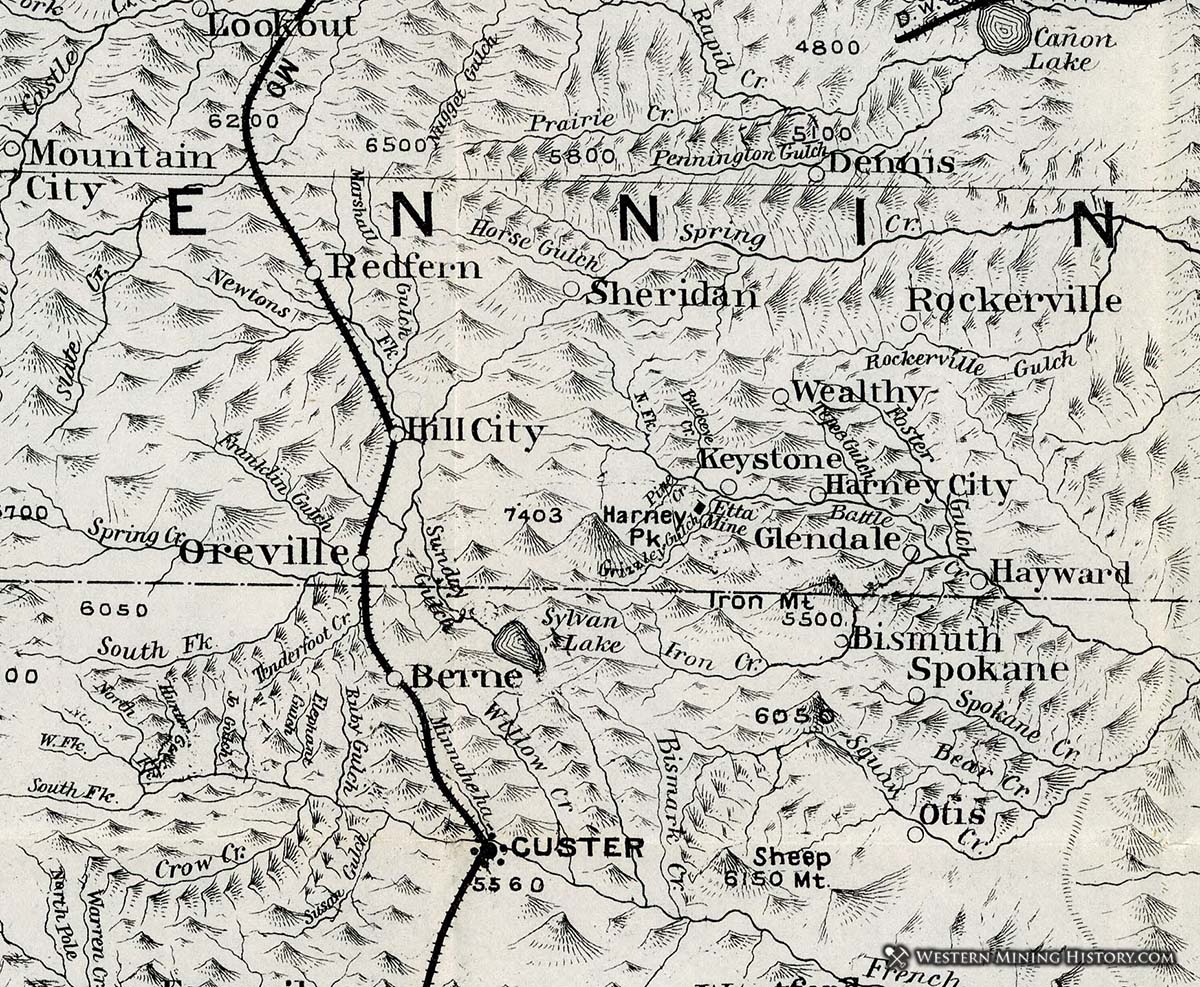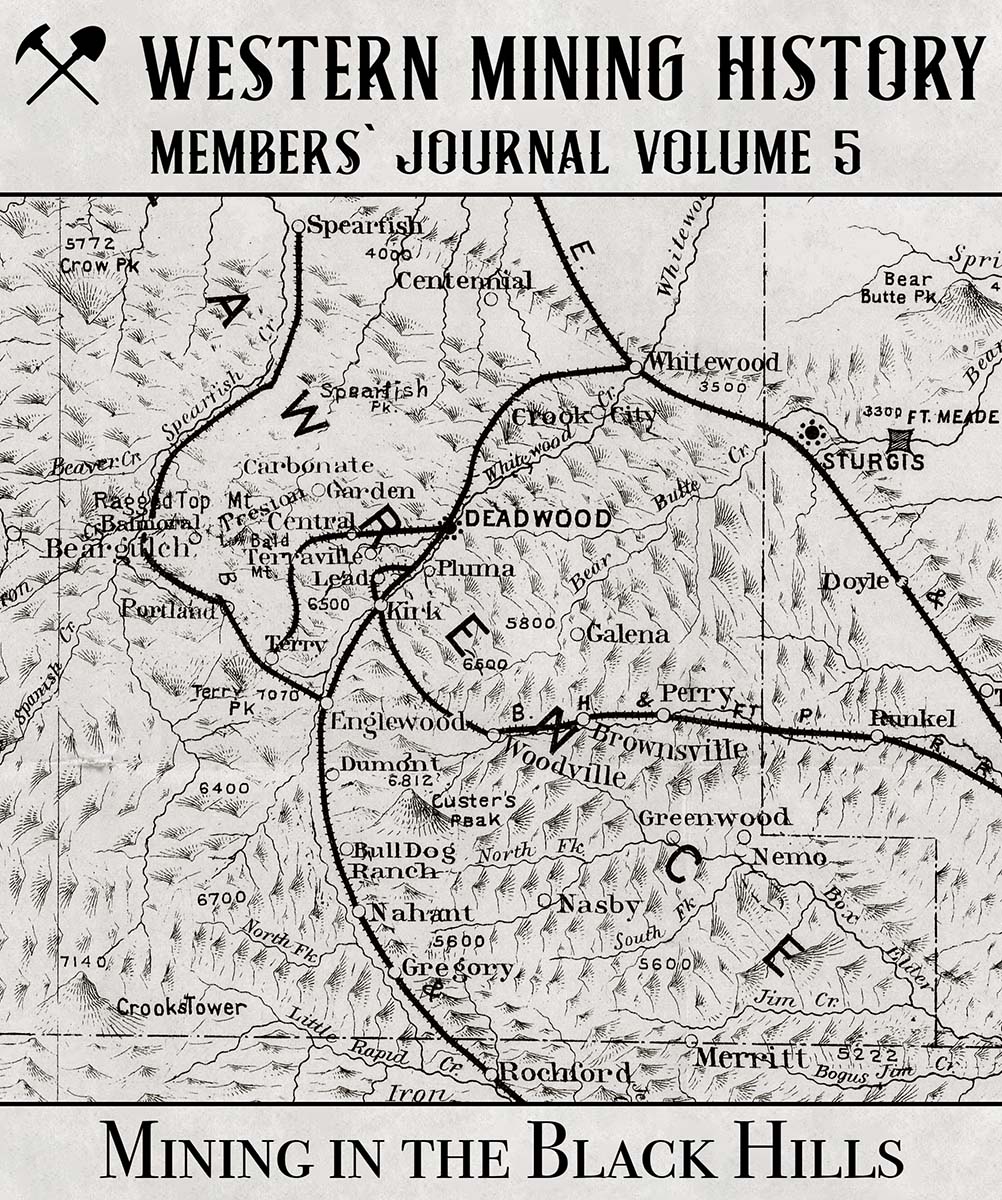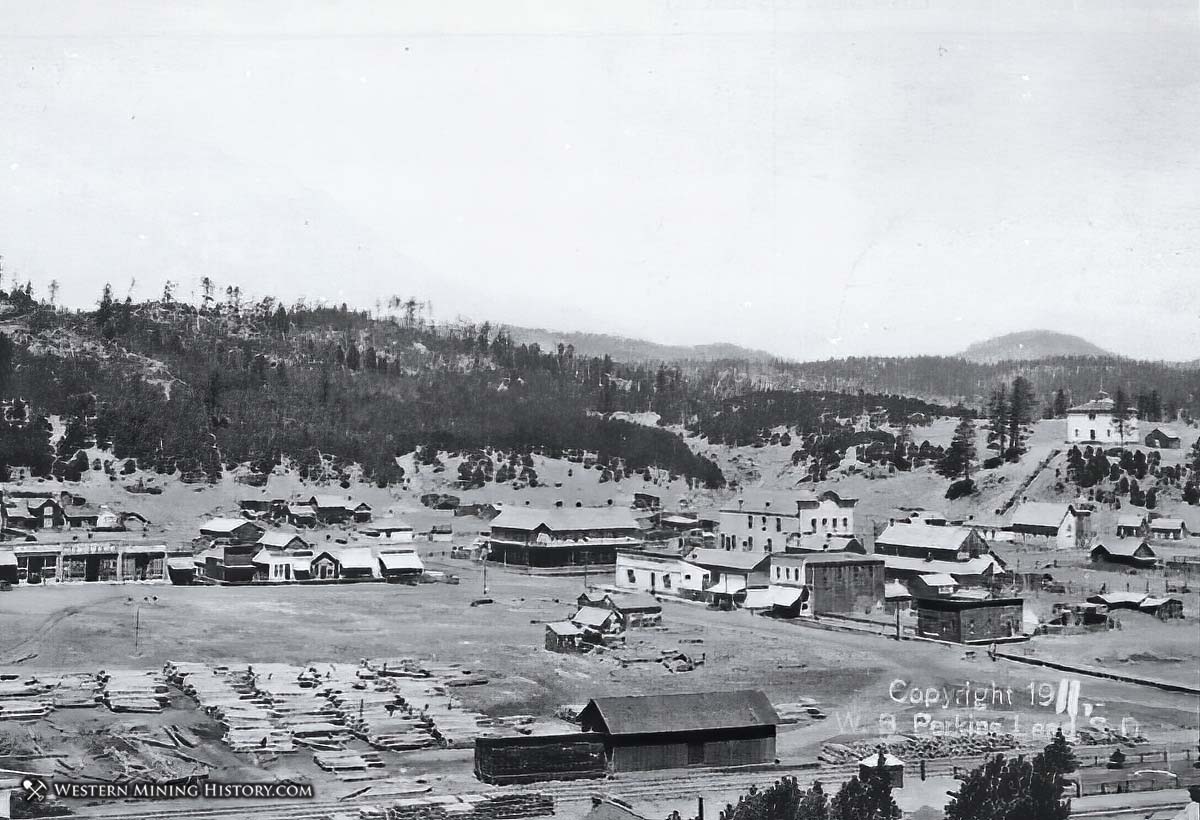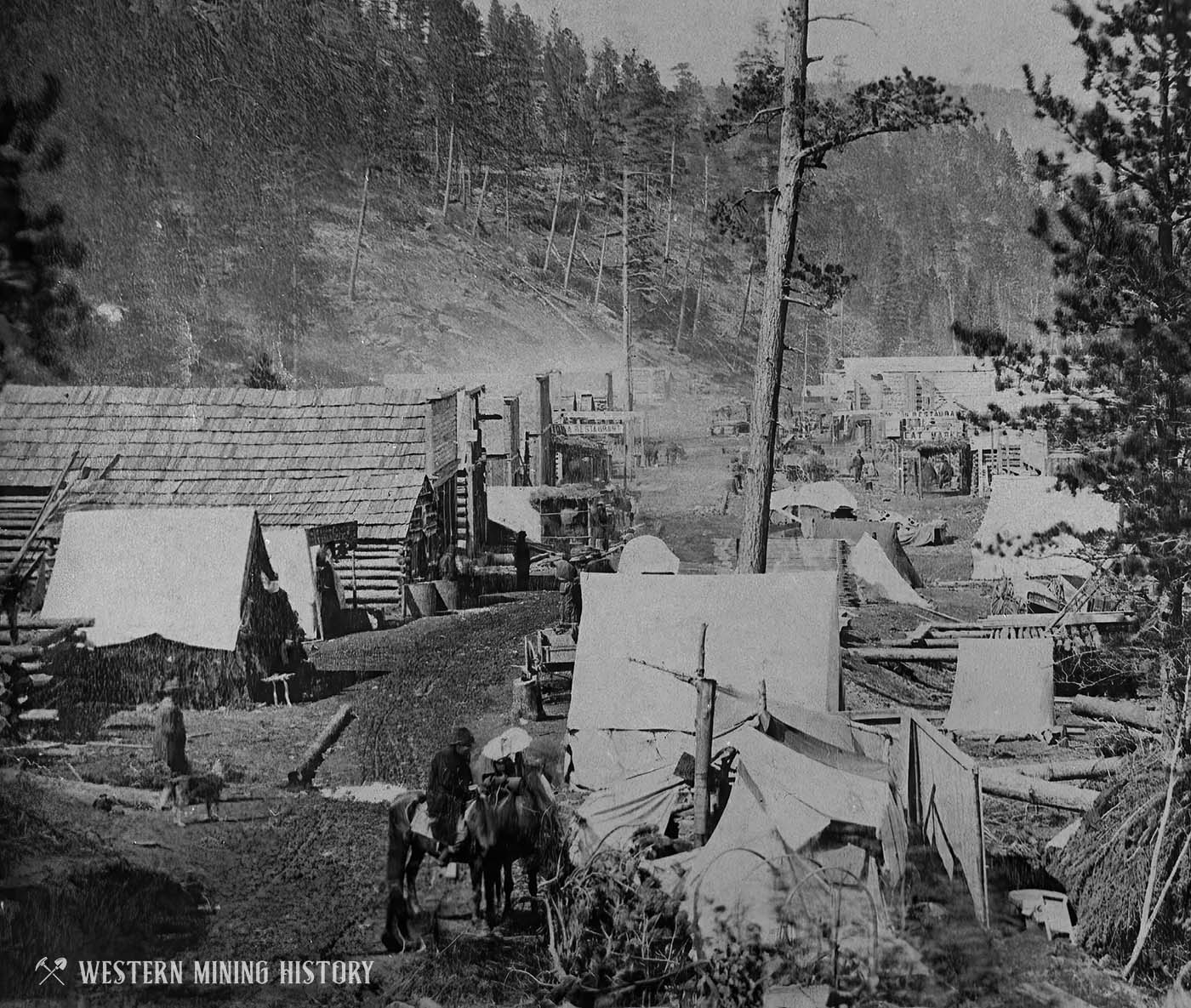Hill City History
Hill City was one of the first gold rush towns to appear in the Black Hills of Dakota Territory in 1876. The initial boom here was short-lived though as most of the residents left when news arrived of the rush to Deadwood.
Initially mining at this location was for placer gold in the surrounding hills, but these deposits were quickly exhausted. Hill City was on its last legs by 1883 when the development of tin mines renewed the local mining industry and the town. The tin mines became a major industry, attracting a railroad by 1890.
The 1890s were an exciting time at Hill City, with several thousand people living in the area in the early part of that decade. Although the tin mining industry declined after 1894, in 1904 Hill City was still prosperous enough to be featured in the 1904 publication Black Hills Illustrated, the text of which is included below.
Although tin mining was responsible for Hill City's big boom around 1890, notable gold mining did occur in the area. The USGS states the following on the gold mines of the area:
The Hill City district is an area of widely scattered gold deposits in western Pennington County in the vicinity of Hill City, near the headwaters of Spring Creek and around Rochford to the northwest of Hill City. Although production figures are incomplete for the early years, it is estimated that the Hill City district had a minimum total output through 1959 of roughly 35,400 ounces of gold, mostly from lodes. The district was dormant from 1939 through 1959.
Eventually the mines of the area were played out but the town was never abandoned. Today Hill City is a popular tourist destination.

Hill City Described in 1904
Text is from the 1904 publication Black Hills Illustrated.
On the line of the Burlington, in practically the center of the Black Hills, at an altitude of 4,982 feet, surrounded by a great mineral belt, lies Hill City, which had its first inception in the spring of 1876, it being at that time practically the second log-cabin town of the Hills, coming directly as a placer camp after the rush to Custer.
At that time two solid streets of cabins stretched north and south from bluff to bluff. The placering was mainly dry digging on side gulches. When the stampede went that fall to Deadwood the town was practically deserted, and there was little revival until the advent of the Harney Peak Tin Mining Company in 1887 and the Burlington Railway in the summer of 1890. At this time over 3,000 people poured in, and the town so remained until the closing down of the Harney Peak, in 1892.
It may be well to say here that the business of this company was badly and extravagantly managed, and whatever its subsequent future, its failure must be laid at the door of the officers, for no excuse could reasonably be offered for the buying of 1,500 claims and the working of them all, using every particle of ore instead of selecting that which could be worked to advantage. In this way, of course, they ran in a great deal of bare ore for treatment and their results were brought to a minimum, whereas there are quite a number of already discovered veins of large size in the Black Hills that will easily pay 3 per cent of tin per ton at a cost of not half that amount.
The Harney Peak Company went into the hands of a receiver and closed down work, and this unquestionably was a great misfortune for Hill City; but at the present moment some very excellent gold mines are opening up in the immediate vicinity, copper has been found in good quantities, a tin mine yielding well will start its mill in the near future, and, while no boom exists at present, the town is advancing to a sure future. The population is now about 600. The townsite was located as a mining ground in 1878, and was then sold to the Harney Peak Mining Company, patented by them in 1888, and deeded or leased to the present property holders.
The surrounding ranches of farming and cattle industries make considerable business for Hill City. The ranches in the mountain parks raise fine potatoes, oats, vegetables and hay. They are very productive and oats run as high as 50 and 60 bushels to the acre. There are seldom any droughts, as the ranches are in valleys, and, therefore, self-irrigated. Experiments with small fruits have been very satisfactory, and fruits command good prices. The cattle industry is also very considerable, as most of the ranches have herds. Lumbering cuts quite a figure.
T. W. March has a sawmill one mile from town and has a planer in town. In the last two years he has sawed 300,000 feet of local lumber annually, and has brought each year from Seattle, Wash., 50,000 feet of cedar and fir; also a great many red cedar shingles. All the lumber is consumed in the city and surrounding mines. There is another mill two and one-half miles from town, which sawed 400,000 feet last summer. There are four mills on the way to Keystone and another one five miles from Hill City. The native lumber is far superior for finishing than that imported, but as yet the proper kilns for drying have not been erected.
R. J. Truax, a large mine owner, has a brick kiln on the edge of town, and manufactures an especially good brick, using the creek bottom clay, which is of the finest quality for such purposes.
The school system is of the best. A large school building is on an elevation above the city, has four commodious schoolrooms, and is in charge of Professor L. W. Rooney. There are two assistant teachers, and pupils are taken from the first to the ninth grade, inclusive, or from the primary through the regular eight-year common school course, and with one year of high school work afterward. In the last three years military drill and tactics are taught, and the last year of high school embraces algebra, grammar and composition, bookkeeping, commercial and physical geography, civil government and geology.
There are four churches-Baptist, Episcopal, Methodist and Roman Catholic-one newspaper, an opera house, which is one of the best halls in the Hills, and two hotels, of which the Harney Peak Hotel is managed by Zachariah Taylor, who is well known as a hotel man, having had charge some years ago of the Paxton Hotel at Omaha. This hotel is commodious, has over twenty bedrooms and will be refurnished and refitted in the near future.
Of societies, the Masonic, Odd Fellows, Modern Woodmen, Miners' Union and Knights of Pythias are well represented. The old soldiers also have a post. The ladies of the town are represented by the Eastern Star, Royal Neighbors, Degree of Honor and Rebekahs.
The Hill City Bank, which was opened for business January 31, 1903, has had a phenomenal record to date... This bank is one of the few buying placer gold today.
It would surprise residents of many larger cities to know the enormous business done by some of the hardware and general merchandise establishments of Hill City, but, of course, the population of the town itself is practically only a supply department for a very large population.
Mining in the Black Hills

Western Mining History Member's Journal Volume 5: "Mining in the Black Hills", takes a closer look at the distribution of mining districts and towns the Black Hills of South Dakota.
Deadwood: The Ultimate Photo Collection
The Black Hills Gold Rush was one of the most significant historical events in the western United States. Deadwood: The Ultimate Photo Collection contains over 50 images capturing the early history of this famous gold region.

